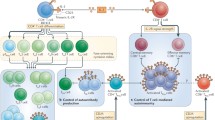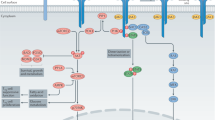Conclusions
Leflunomide is an antiphlogistic and immunomodulating agent that has been shown to be effective in preventing and healing autoimmune disorders and reactions leading to organ graft rejection. From our preliminary clinical data [4], we now have hopes that these effects, observed in experimental animals, can truly be transferred to humans.
Although we are far from understanding the mode of action of leflunomide, we are slowly gathering some insight. A good many of the immunosuppressive effects of leflunomide can be attributed to the antagonistic effects it has on responses to many cytokines, most likely through receptor expression and signal transduction (tyrosine kinase inhibition). The inhibition of transplant rejection could be explained by interference with the activity of IL-2 and IL-4, i.e. the interference of cytotoxic T cell formation. Considering, further, that increased IL-3-like activity has been reported in autoimmune MRL/lpr mice [23], and that it is felt that this amplified activity may contribute to the pathology of their illness [23], then the interference of leflunomide with IL-3 may, together with the antagonistic activity of TRF and specifically IL-4, explain some of the disease modifying properties of this drug in animals with SLE-like and other autoimmune diseases. Also, interference with responses to IL-6 (Germann, personal communication) could be responsible for the suppression of acute-phase proteins observed in adjuvant-diseased rats [24].
Our data concerning tyrosine kinase inhibition as a hypothetical mechanism for the non-cytotoxic and reversible antiproliferative activity of A77 1726 are in many ways, intriguing. First of all, many known receptors for growth factors are associated with tyrosine kinase, i.e. EGF [35], IL-2 (the high binding, 75 kDa chain) [21], IL-3 [26], G-CSF, GM-CSF and TNF-α [9]. Leflunomide antagonizes all of these mediators. On the other hand, IL-1, which is not antagonized by leflunomide, is not associated with tyrosine kinase, but with threonine and serine kinase [11]. Much more work must be conducted before we can be sure that tyrosine kinase inhibition is important for the mode of action of leflunomide.
Another important aspect of this drug is its inhibitory effect on the release of histamine from basophils and mast cells, because of its role in inflammatory reactions. Relating to our findings on the activity of leflunomide on murine SLE-like disorders, it has been reported recently that SLE patients often exhibit abnormal production of antibodies to IgE, and that these autoantibodies may, by activating mast cells and basophils, play a consequential part in the release of vasoactive amines, thus leading to generalized tissue injury [15].
We are confident that leflunomide will prove to be an effective drug in combating human autoimmune disorders. Indeed, we already have preliminary evidence for this, from studies of its effects on humans suffering from autoimmune diseases. Moreover, this drug provides a tool for gaining new insights into both the mechanisms leading to such ailments and their therapeutic control, and as such may facilitate the discovery of even more proficient drugs or other means to modulate these malfunctioning immune reactions.
Similar content being viewed by others
References
Alvord EC (1984) The challenge: how good a model of MS is EAE today?. In: Alvord EC, Kies MW, Suckling AJ (eds) Experimental allergic encephalomyelitis: a useful model for multiple sclerosis. Liss, New York, pp 3–5
Bartlett RR (1986) Immunopharmacological profile of HWA486, a novel isoxazol derivative. II. In vivo immunomodulating effects differ from those of cyclophosphamide, prednisolone or cyclosporin A. Int J Immunopharmacol 8:199
Bartlett RR (1988) Cyclophosphamide. In: Bray MA, Morley J (eds) The pharmacology of lymphocytes. Springer, Berlin Heidelberg New York, pp 453–469
Bartlett RR, Schleyerbach R (1985) Immunopharmacological profile of a novel isoxazol derivative, HWA486, with potential antirheumatic activity. I. Disease modifying action on adjuvant arthritis of the rat. Int J Immunopharmacol 7:7
Bartlett RR, Raiss RX, Popovic S, Schleyerbach R (1986) Immunologic, histologic and ultrastructural studies in autoimmune MRL/L mice. In: Kuettner KE, Schleyerbach R, Hascall VC (eds) Articular cartilage biochemistry. Raven Press New York, pp 391–412
Bartlett RR, Popovic S, Raiss RX (1988) Development of autoimmunity in MRL/lpr mice and the effect of drugs on this murine disease. Scand J Rheumatol [Suppl] 75:290
Bartlett RR, Mattar T, Weithmann U, Anagnostopulos H, Popovic S, Schleyerbach R (1989) Leflunomide (HWA 486): a novel immunorestoring drug. In: Lewis AJ, Doherty NS, Ackerman NR (eds) Therapeutic approaches to inflammatory diseases. Elsevier, New York, pp 215–228
Bartlett RR, Dimitrijevic M, Mattar T, Zielinski T, Germann T, Rüde E, Thoenes GH, Küchle CCA, Schorlemmer H-U, Bremmer E, Finnegan A, Schleyerbach R (1991) Leflunomide (HWA 486), a novel immunomodulating compound for the treatment of autoimmune disorders and reactions leading to transplantation rejection. Agents Actions 32:10
Evans JPM, Mire-Sluis AR, Hoffbrand AV, Wickremasinghe RG (1990) Binding of G-CSF, GM-CSF, tumor necrosis factor-α and γ-interferon to cell surface receptors on human myeloid leukemia cells triggers rapid tyrosine and serine phosphorylation of a 75-Kd protein. Blood 75:88
Fassbender HG (1986) Joint destruction in various arthritic diseases. In: Kuettner KE, Schleyerbach R, Hascall VC (eds) Articular cartilage biochemistry. Raven Press, New York, pp 371–389
Gasllis B, Pricket KS, Jackson J, Slack J, Schooley K, Sims JE, Dower SK (1989) IL-1 induce rapid phosphorylation of the IL-1 receptor. J Immunol 143:3235
Giant TT, Mikecz K, Arzomanian A, Poole A (1987) Proteoglycan-induced arthritis in BALB/c mice: clinical features and histopathology. Arthritis Rheum 30:201
Giant TT, Fülöp C, Mikecz K, Buzar G, Erhardt P (1990) Proteoglycan-specific autoreactive antibodies and T-lymphocytes in experimental arthritis and human rheumatoid joint disease. Biochem Soc Trans 18:796
Giant TT, Mikecz K, Bartlett RR, Deak F, Thonar E J-M A, Williams JM, Mattar T, Kuettner KE, Schleyerbach R (1992) Immunomodulation of proteoglycan-induced progressive polyarthritis by leflunomide. Int J Immunopharmacol 23:105–116
Gruber BL, Kaufman LD, Marchese MJ, Roth W, Kaplan AP (1988) Anti-IgE autoantibodies in systemic lupus erythematosus. Prevalence and biologic activity. Arthritis Rheum31:1000
Hambleton P, McMahon S (1990) Drug actions on delayed-type hypersensitivity in rats with developing and established adjuvant arthritis. Agents Actions 29:328
Hang M, Theofilopoulos AN, Dixon FJ (1982) A spontaneous rheumatoid arthritis-like disease In MRL/L mice. J Exp Med 155:1690
Küchle CCA, Thoenes GH, Langer KH, Schorlemmer HU, Bartlett RR, Schleyerbach R (1991) Prevention of kidney and skin graft rejection in rats by lefiunomide, a new immunomodulating agent. Transplant Proc 23:1083
Lewis AJ (1978) Evaluation of the ability of anti-rheumatic drugs to suppress hyperaemia and increased vascular permeability. In: Dumonde DC, Jasani MK (eds) The recognition of anti-rheumatic drugs. MTP Press, Lancaster, pp 87–111
McFarlin DE, Blank SE, Kibler RF, McKneally S, Shapira R (1973) Experimental allergic encephalomyelitis in the rat: response to encephalitogenic proteins and peptides. Science 179:478
Mills GB, May C, McGill M, Fung M, Baker M, Sutherland R, Greene WC (1990) Interleukin 2-induced tyrosine phosphorylation. Interleukin 2 receptor β is tyrosine phosphorylated. J Biol Chem 265:3561
Ogawa T, Inazu M, Gotoh K, Hayashi S (1990) Effects of lefiunomide on glomerulonephritis induced by antibasement membrane antibody in rats. Agent Actions 31:321
Ohta Y, Tamura S, Tezuka E, Sugawara M, Imai S, Tanaka H (1988) Autoimmune MRL/lpr mice sera contain IgG with interleukin 3-like activity. J Immunol 140:520
Pasternak RD, Wadopian NS, Wright RN, Siminoff P, Gylys JA, Buyniski JP (1987) Disease modifying activity of HWA 486 in rat adjuvant-induced arthritis. Agents Actions 21:241
Paul WE, Ohara J (1987) B cell stimulatory factor-1 interleukin 4. Annu Rev Immunol 5:429
Pelech SL, Paddon HB, Charest DL, Federsppiel BS (1990) IL-3-induced activation of protein kinases in the mast cell/megakaryocyte R6-Xe. 4 line. J Immunol 144:1759
Peper R, Alvarez B, Colombo C, Schroder H (1971) The use of a standardized adjuvant arthritis assay to differentiate between antiinflammatory and immunosuppressive agents. Proc Soc Exp Biol Med 137:506
Popovic S, Bartlett RR (1986) Disease modifying activity of HWA486 on the development of SLE in MRL/1 mice. Agents Actions 19:313
Popovic S, Bartlett RR (1987) The use of the murine chronic graft versus host (CGVH) disease, a model for systemic lupus erythematosus (SLE), for drug discovery. Agents Actions 21:284
Schimpel A, Hübner L, Wong CA, Wecker E (1980) Distinction between T helper cell replacing factor (TRF) and T cell growth factor (TCGF). Behring Inst Mitt 67:221
Theofilopoulos AN, Dixon FJ (1981) Etiopathogenesis of murine SLE. Immunol Rev 55:179
Thoenes GH, Sitter T, Langer KH, Bartlett RR, Schleyerbach R (1989) Leflunomide (HWA 486) inhibits experimental autoimmune tubulointerstitial nephritis in rats. Int J Immunopharmacol 11:921
Ulrichs K, Kaitschick J, Bartlett RR, Müller-Ruchholtz W (1993) Suppression of natural xenophile antibodies with the novel immunomodulating drug leflunomide. Transplant Proc (in press)
Waterfield MD (1989) Epidermal growth factor and related molecules. Lancet I:1243
Yarden Y, Ullrich A (1988) Growth factor receptor tyrosine kinases. Annu Rev Biochem 57:443
Author information
Authors and Affiliations
Rights and permissions
About this article
Cite this article
Bartlett, R.R., Anagnostopulos, H., Zielinski, T. et al. Effects of leflunomide on immune responses and models of inflammation. Springer Semin Immunopathol 14, 381–394 (1993). https://doi.org/10.1007/BF00192310
Issue Date:
DOI: https://doi.org/10.1007/BF00192310




